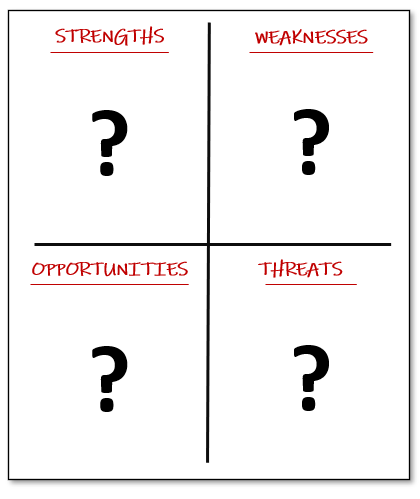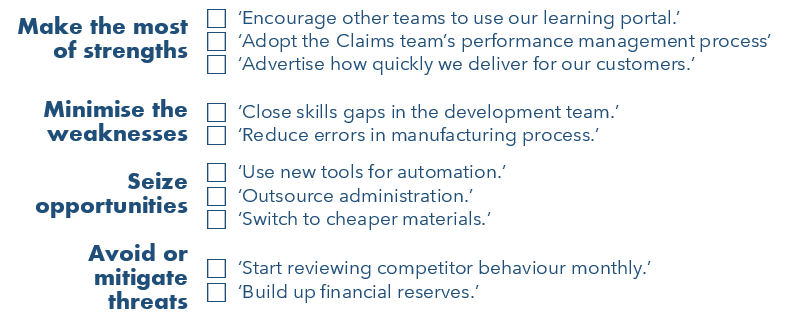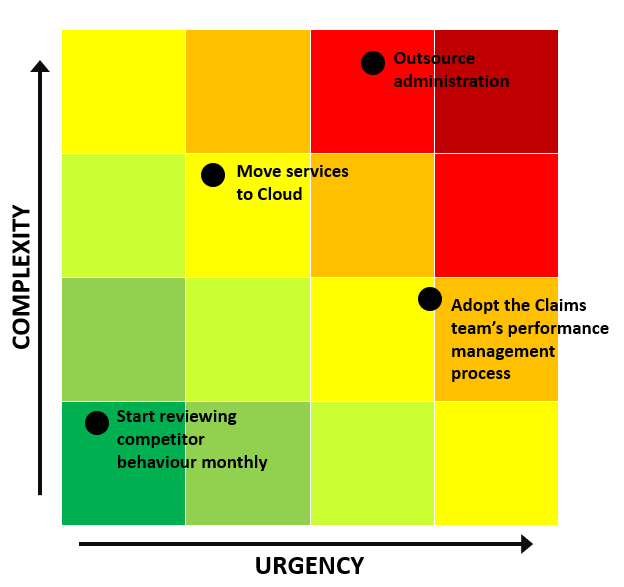Most people involved in any kind of business change will have heard of SWOT analysis. It’s a technique for eliciting information about a situation or domain, and it is frequently used in strategic planning or business process improvement workshops.

SWOT is often seen as being somewhat “basic” – that’s probably in part down to how well known it is, and how long it’s been around – however, I find it can be a very powerful and versatile tool when used well.
You can apply it on a grand scale for a whole organisation, or just within a particular domain such as a team or product.
To get maximum benefit from the technique, it’s important to go beyond just identifying points and putting them on a grid.
How to draw out useful points
When it comes to populating the grid, I find it best to apply some structure. Combining SWOT with other techniques can help bring out as many good ideas as possible, and helps ensure key ideas aren’t overlooked.
Strengths and weaknesses can be highlighted through performing a Resource Audit. This could be a detailed exercise in its own right or could simply be a directed conversation in a workshop. Choose relevant topics (such as technology, people, finances) for your stakeholders to brainstorm ideas. I generally come armed with small pieces of paper labelled with symbols for the various headings!
For opportunities and threats, PESTLE analysis provides a great framework for bringing out ideas. Perhaps you could ask stakeholders to bring along any existing risk assessments in the organisation.
If you’re examining products or services, consider additional techniques such as Boston Box or Ansoff’s Matrix. If the domain is the wider organisation, think about using Balanced Business Scorecard, POPIT analysis or value stream analysis.
Using appropriate tools, you’ll quickly find you’ve got a grid overflowing with points!
But don’t stop there!
To really get the most of your SWOT analysis, you need to consider strategies to address all the points identified. Strengths should be exploited, weaknesses eliminated, opportunities seized, and threats dodged or mitigated. Ask your stakeholders what actions they think would best address each point. In particular, think about how strengths can be used to address other points.

By phrasing items with active verbs, your stakeholders will be identifying candidate change initiatives. Some of these could be addressed “in the business”, while others could form the scope of projects and programmes.
Establishing what’s most important
Consider looking at prioritisation – your stakeholders are likely to have a good idea of which things need addressing soonest. To help them articulate this, guide them through building a Heat Map and populating it with the points from your SWOT grid.
There are various factors you could use for the axes, such as complexity, cost, change over time, or potential benefit. Pick two that seem most appropriate and see where they lead you.

In summary…
By adopting a more structured approach to SWOT analysis, you can quickly guide your stakeholders to identifying important candidates for change.
- Combine with other techniques to draw out more ideas
- Identify ways to address each point
- Create a Heat Map to understand priorities
Your stakeholders will come away from your workshop feeling they’ve discovered real insights about the situation and will have a shared understanding of what the organisation should seek to do next.